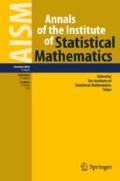Abstract
If \(F\) is a full factorial design and \(D\) is a fraction of \(F\), then for a given monomial ordering, the algebraic method gives a saturated polynomial basis for \(D\) which can be used for regression. Consider now an algebraic basis for the complementary fraction of \(D\) in \(F\), built under the same monomial ordering. We show that the basis for the complementary fraction is the Alexander dual of the first basis, constructed by shifting monomial exponents. For designs with two levels, the Alexander dual uses the traditional definition for simplicial complexes, while for designs with more than two levels, the dual is constructed with respect to the basis for the design \(F\). This yields various new constructions for designs, where the basis and linear aberration can easily be read from the duality.





Similar content being viewed by others
References
Babson, E., Onn, S., Thomas, R. (2003). The Hilbert zonotope and a polynomial time algorithm for universal Gröbner bases. Advances in Applied Mathematics, 30(3), 529–544.
Bayer, D., Morrison, I. (1988). Standard bases and geometric invariant theory. I. Initial ideals and state polytopes. Journal of Symbolic Computation, 6(2–3), 209–217.
Becker, T., Weispfenning, V. (1991). The Chinese remainder problem, multivariate interpolation, and Gröbner bases. In ISSAC ’91: Proceedings of the 1991 international symposium on symbolic and algebraic computation (pp. 64–69).
Bernstein, Y., Maruri-Aguilar, H., Onn, S., Riccomagno, E., Wynn, H. (2010). Minimal average degree aberration and the state polytope for experimental designs. Annals of the Institute of Statistical Mathematics, 62, 673–698.
Box, G. E. P., Hunter, J. S., Hunter, W. G. (2005). Statistics for experimenters: Design, innovation, and discovery (2nd ed.). Hoboken, NJ: Wiley Series in Probability and Statistics, Wiley-Interscience.
CoCoATeam. (2009). CoCoA: A system for doing Computations in Commutative Algebra. http://cocoa.dima.unige.it.
Cox, D., Little, J., O’Shea, D. (2007). Ideals, varieties, and algorithms: An introduction to computational algebraic geometry and commutative algebra (3rd ed.). Undergraduate Texts in Mathematics. New York: Springer.
Grayson, D. R., Stillman, M. E. (2009). Macaulay2: A software system for research in algebraic geometry. http://www.math.uiuc.edu/Macaulay2/.
Herzog, J., Hibi, T. (2011). Monomial ideals. Graduate texts in mathematics. Vol. 260. London: Springer.
Jensen, A. N. (2011). Gfan: A software system for Gröbner fans and tropical varieties. http://home.imf.au.dk/jensen/software/gfan/gfan.html.
Maruri-Aguilar, H., Notari, R., Riccomagno, E. (2007). On the description and identifiability analysis of experiments with mixtures. Statistica Sinica, 17(4), 1417–1440.
Maruri-Aguilar, H., Sáenz-de Cabezón, E., Wynn, H. (2012). Betti numbers of polynomial hierarchical models for experimental designs. Annals of Mathematics and Artificial Intelligence, 64(4), 411–426.
Miller, E., Sturmfels, B. (2005). Combinatorial commutative algebra. Graduate texts in mathematics. Vol. 227. New York: Springer.
Mora, T., Robbiano, L. (1988). The Gröbner fan of an ideal. Journal of Symbolic Computation, 6(2–3), 183–208.
Nelder, J. A. (1977). A reformulation of linear models. Journal of the Royal Statistical Society Series A General, 140(1), 48–76 (with discussion).
Onn, S., Sturmfels, B. (1999). Cutting corners. Advances in Applied Mathematics, 23(1), 29–48.
Peixoto, J. L. (1990). A property of well-formulated polynomial regression models. The American Statistician, 44(1), 26–30.
Pistone, G., Riccomagno, E., Wynn, H. (2001). Algebraic statistics. Monographs on statistics and applied probability. Vol. 89. Boca Raton: Chapman & Hall/CRC.
Pistone, G., Rogantin, M. P. (2008). Indicator function and complex coding for mixed fractional factorial designs. Journal of Statistical Planning and Inference, 138(3), 787–802.
Pistone, G., Wynn, H. (1996). Generalised confounding with Gröbner bases. Biometrika, 83, 656–666.
Riccomagno, E. (2009). A short history of algebraic statistics. Metrika, 69(2–3), 397–418.
Acknowledgments
The first and third authors would like to thank the Isaac Newton Institute for Mathematical Sciences, where part of this work was carried out during the Design and Analysis of Experiments program. They also acknowledge the EPSRC grant EP/D048893/1 (MUCM project). The second author acknowledges grant MTM2009-13842-C02-01 from Ministerio de Ciencia e Innovación of Spain.
Author information
Authors and Affiliations
Corresponding author
About this article
Cite this article
Maruri-Aguilar, H., Sáenz-de-Cabezón, E. & Wynn, H.P. Alexander duality in experimental designs. Ann Inst Stat Math 65, 667–686 (2013). https://doi.org/10.1007/s10463-012-0390-9
Received:
Revised:
Published:
Issue Date:
DOI: https://doi.org/10.1007/s10463-012-0390-9




